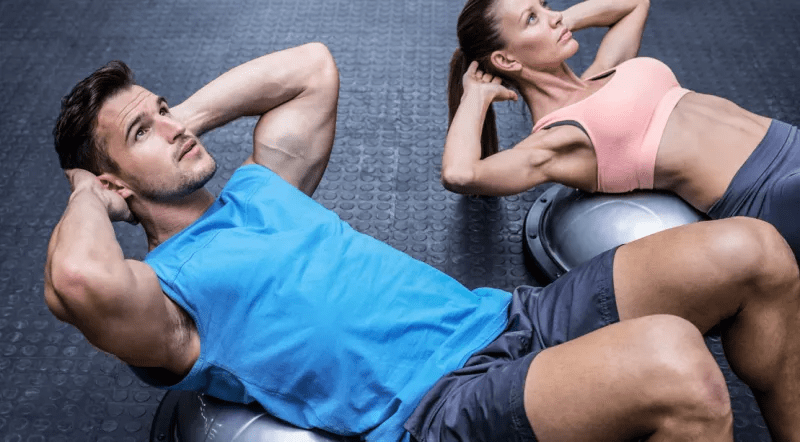We delve into the crucial realm of core exercises gyms, a fundamental component of any well-rounded fitness routine. Your core isn’t just about achieving that coveted six-pack; it’s about building a strong foundation for overall functional fitness and injury prevention.
The core encompasses more than just the abdominal muscles; it includes the pelvis, lower back, and hips. Think of it as the central link that connects your upper and lower body. Strengthening this area is akin to fortifying the cornerstone of a building, providing stability and support for various movements.
Importance of Core Strength
1. Enhanced Stability: A robust core is the linchpin for stability in almost every exercise. Whether you’re lifting weights, running, or doing yoga, a stable core ensures proper form and reduces the risk of injuries.
Example: Picture a squat. A strong core helps you maintain an upright posture, preventing your lower back from arching excessively.
2. Improved Posture: Core strength contributes significantly to good posture. It acts as a natural corset, supporting your spine and helping you stand tall and confident.
Example: As you sit at your desk, a strong core prevents slouching, reducing strain on your back.
3. Injury Prevention: A stable core protects your spine and surrounding muscles, reducing the likelihood of injuries, especially in activities that involve twisting or sudden movements.
Example: Playing sports like golf or tennis becomes safer with a well-conditioned core, minimizing the risk of strain.
Effective Core Exercises
1. Plank Variations:
1. Standard Plank: Maintain a straight line from head to heels, engaging your core.
2. Side Plank: Targets the obliques for lateral stability.
2. Russian Twists:
1. Sit on the floor, lean back slightly, and rotate your torso while holding a weight or medicine ball.
2. This engages both the upper and lower abdominals.
3. Hanging Leg Raises:
1. Hang from a pull-up bar and lift your legs, targeting the lower abdominals and hip flexors.
4. Dead Bug Exercise:
1. Lie on your back, extending your arms and legs.
2. Alternate lowering one arm and the opposite leg while keeping your lower back pressed to the floor.
5. Bird Dog Exercise:
1. Start on all fours, extend one arm and the opposite leg, then return to the starting position.
2. This exercise promotes balance and stability.
Programming Tips
1. Consistency is Key: Include core exercises in your routine 2-3 times a week. Gradually progress in intensity and duration for optimal results.
2. Form Over Repetition: Maintain proper form during every exercise to ensure you’re effectively targeting the core muscles and minimizing the risk of injury.
3. Combine with Compound Movements: Integrate core exercises into your full-body workouts to synergize muscle engagement and promote overall functional strength.
Read Also 8 Amazing Importance of Health and Fitness to Life
Advanced Core Training Techniques

1. Anti-Rotation Exercises:
Include exercises that challenge your core’s ability to resist rotation, such as Pallof Presses or Cable Chops. These movements target the obliques and improve stability under load.
Example: Perform a Pallof Press by standing sideways to a cable machine, grabbing the handle with both hands at chest height, and extending your arms. Resist the rotational force as you hold the position.
2. Dynamically Loaded Movements:
Integrate dynamic movements like Medicine Ball Slams or Woodchoppers to engage the core through a full range of motion. These exercises enhance power and coordination.
Example: Execute a Woodchopper by starting with a weight at shoulder height, rotating your torso, and bringing the weight diagonally across your body while pivoting on your feet.
3. Incorporate Unstable Surfaces:
Train your core in real-world scenarios by incorporating stability balls, BOSU balls, or balance pads. This forces your core to work harder to maintain equilibrium.
Example: Perform a plank on a stability ball, challenging your core to stabilize as the ball moves beneath you.
Progression and Adaptation
1. Gradual Progression:
1. As your core strength improves, gradually increase the difficulty of exercises.
2. This could involve adding resistance, increasing the duration of holds, or progressing to more advanced variations.
2. Mind-Muscle Connection:
1. Focus on the mind-muscle connection during core exercises.
2. Visualize the targeted muscles working, ensuring maximum engagement and effectiveness.
3. Listen to Your Body:
1. Pay attention to your body’s signals.
2. If an exercise causes discomfort beyond the normal burn, reassess your form or modify the movement to prevent injury.
Lifestyle Integration
1. Functional Fitness:
1. Recognize the importance of core strength in everyday activities.
2. Whether you’re lifting groceries, playing with your kids, or performing household chores, a strong core enhances your ability to move efficiently.
2. Post-Workout Stretching:
1. Include stretching in your routine to maintain flexibility and prevent muscle imbalances.
2. Yoga poses like Downward Dog or Cobra pose are excellent choices.
Conclusion
In the realm of fitness, the core is not just a set of muscles to be sculpted; it’s a dynamic system that supports your body in all its movements.
By incorporating a diverse range of core exercises, focusing on proper form, and gradually progressing in intensity, you’ll not only achieve a strong and aesthetically pleasing midsection but also cultivate a foundation for lifelong health and physical performance.
Remember, your core is at the heart of your body’s strength and resilience. Treat it with the attention and care it deserves, and you’ll witness transformative results in your fitness journey. Stay committed, stay focused, and let your core be the powerhouse that propels you toward your fitness goals.
Read Also How To Fix a Garbage Disposal Jam
